Scr0t
Hazard to Others
  
Posts: 118
Registered: 14-1-2012
Location: Europe
Member Is Offline
Mood: Desiccated
|
|
Preparation of pyrrolidine via decarboxylation of l-proline
Several different methods of decarboxylation were applied to the amino-acid l-proline in attempts to obtain the cyclic secondary amine pyrrolidine.
Pyrrolidine can substitute piperidine in many applications.
Copper catalysed decarboxylation
50.0g l-proline mixed with 5.0g basic copper carbonate Cu2(OH)2CO3 [1] and heated directly over an
electric hotplate (~1.5kW).
When plate temperature was ~320°C a small amount of product came across (going by smell but had obvious water contamination) but was very slow. It
was not until plate temperature was ~420°C when collection rate picked-up (~1 drop every 1-2s), the collected product was a pale yellow colour and
smelled 'charred', collection was continued at 420-450°C for about 3hrs when it slowed considerably yet the contents in the distilling flask was
still significant [2].
The collected material was dried over a few grams of solid NaOH and then distilled, the material collected between 85-89°C weighed 3.1g Yield
of pyrrolidine 10%.
A clear higher boiling point residue was left behind (bp >90°C, ~15ml) in the distilling and was not examined further.
Overall the reaction was very low yielding, required a higher temperature and was sluggish compared to the decarboxylation of niacin to pyridine with
the same catalyst loading.
Copper carbonate is not an effective catalyst for decarboxylation of this substrate and the results are probably no better than
simply heating the proline on its own.
[1] If the mixture is allowed to stand at room temperature for ~24hrs it darkens to a deep blue colour.
[2] Proline reportedly decomposes at its melting point ~200°C, decarboxylation is evidently only a minor component of this.
----------------------------------
Acetophenone catalysed decarboxylation
20.00g l-proline in 80ml acetophenone was set for reflux and heated in an oil bath to 150°C
At ~130°C evolution of CO2 commenced, generation of some water and a mild smell of pyrrolidine from the top of the condenser was noticed.
Over the course of the reaction the solids dissolved and the reaction progressed to a deep orange colour, CO2 evolution rapidly abated at
around 40mins and at 50mins it was removed from the heat.
30ml 36% HCl made up to 100ml was added to the cooled mixture and stirred for 30mins (white mist formed on addition due to the presence of freebase
vapour), the lower aqueous phase was separated and the acetophenone layer washed with 50ml H2O containing a few grams of NaCl to aid with
phase separation, the combined aqueous portions were washed with 2x20ml DCM.
The aqueous phase was cautiously treated with 20g NaOH in 30ml H2O whereupon a separate upper phase formed however this was not
primarily pyrrolidine.
The mixture was distilled with stirring to collect the product and some water (<=92°C), the upper phase that formed earlier remained in the
distillation flask as a few millilitres of a brown viscous oil/goo when cool.
The distillate was treated with a couple of grams of solid NaOH and the upper phase separated and distilled (bp 87°C) to yield 10.85g
pyrrolidine (85%).
----------------------------------
Carvone catalysed decarboxylation
Into a 1L RBF 50.0g l-proline, 500ml turpentine and 2.0g spearmint oil was added and with stirring it was refluxed in an oil bath (~180°C). The
mixture was heated to a rapid reflux (145-160°C).
At 20hrs there was still a few small lumps of what appeared to be unreacted proline in suspension [1] but the reaction was removed
from the heat and allowed to cool. The mixture was treated with 60ml 36% HCl made up to 200ml with H2O and stirred for ~15min.
The mixture was separated (small amount of brown gummy material at the interface), washed with DCM, treated with 40g NaOH in 100ml H2O and
then the whole distilled to collect the product and water. The distillate was treated with a few grams of solid NaOH [2], separated
and distilled to yield 25.2g (82%) pyrrolidine.
The spearmint oil used was the same as that used for successful decarboxylation of tryptophan, the slow reaction is possibly due to a low solubility
of proline in this solvent. Inclusion of some DMSO may improve reaction time.
[1] These lumps turned out to be quite gooey, possibly some proline surrounded by a side-product precipitate.
[2] The two-phase mixture of aqueous NaOH and distillate turned to a pink colour on standing in air.
|
|
|
UC235
National Hazard
   
Posts: 565
Registered: 28-12-2014
Member Is Offline
Mood: No Mood
|
|
Excellent work! I would strongly consider moving the latter two preps to Prepub (maybe with a few pics?)! Pyrrolidine is now a readily accessible
secondary amine for the amateur chemist. I have looked into making morpholine (via diethanolamine) or piperidine (via sodium reduction of pyridine,
see orgsyn) for a Mannich reaction but this is so much easier sounding.
Pyrrolidine readily forms enamines from enolizable ketones and aldehydes which has significant synthetic utility and may have been the source of
separation troubles in the acetophenone prep.
Copper seems to require pyridine-like ligands to function as a decarboxylation catalyst (and I have mostly seem it applied to aromatic carboxylic acid
groups), so I am not sure if it could ever be made to work here.
[Edited on 24-12-2015 by UC235]
|
|
|
skip
Hazard to Self
 
Posts: 54
Registered: 16-5-2015
Member Is Offline
Mood: No Mood
|
|
Piperidine via piperidinecarboxaldhyde , aka formylpiperidine. Non-regulated.
|
|
|
AvBaeyer
National Hazard
   
Posts: 655
Registered: 25-2-2014
Location: CA
Member Is Offline
Mood: No Mood
|
|
Nice piece of work. I have been meaning to try the proline-acetophenone reaction for a while. Now to the lab!
I have made piperidine from the hydrolysis of N- formylpiperidine. It's easy and fast.
AvB
|
|
|
Nicodem
Super Moderator
      
Posts: 4230
Registered: 28-12-2004
Member Is Offline
Mood: No Mood
|
|
Scr0t, I like your report and I hope you don't mind me moving it to Prepublication.
I particularly liked your comparison of the three different methods.
…there is a human touch of the cultist “believer” in every theorist that he must struggle against as being
unworthy of the scientist. Some of the greatest men of science have publicly repudiated a theory which earlier they hotly defended. In this lies their
scientific temper, not in the scientific defense of the theory. - Weston La Barre (Ghost Dance, 1972)
Read the The ScienceMadness Guidelines!
|
|
|
Nicodem
|
Thread Moved
25-12-2015 at 06:55 |
skip
Hazard to Self
 
Posts: 54
Registered: 16-5-2015
Member Is Offline
Mood: No Mood
|
|
I have read articles of glucose catalyzing the formation of cyclic amines from amino acids . I never tried it. I did try thermal decarboxylation of
lysine to form cadaverine, and then to piperidine witch is the same procedure for pyrrolidine from proline and piperazine from ethylene diamine. I
was unsuccessful in my attemps and just moved on and bought the compounds. It was interesting and fun but not really practical because of time.
|
|
|
AvBaeyer
National Hazard
   
Posts: 655
Registered: 25-2-2014
Location: CA
Member Is Offline
Mood: No Mood
|
|
The importance of Schiff base (imine) formation in these decarboxylation reactions cannot be overstated. Some time ago I ran across a post by Nicodem
alluding to this fact but I do no recall any references cited for this. Here are two which address the importance of imine formation (and imine
hydolysis). The first also has data on the transamination side reaction.
1. AF Al-Sayyeb and A Lawson, J. Chem. Soc. (C), 1968, 406
2. Patent application: US2014/0275569 A1 (Sept. 18, 2014)
AvB
|
|
|
careysub
International Hazard
    
Posts: 1339
Registered: 4-8-2014
Location: Coastal Sage Scrub Biome
Member Is Offline
Mood: Lowest quantum state
|
|
Other Amino Acids?
Decarboxylating tryptophan can be use to make tryptamine
Proline can be used to make pyrrolidine
That got me wondering if there are any other similar useful preparations from amino acids.
It looks like histidine would give histamine (?), and phenylalanine would give phenylethylamine, both easily available and not too interesting.
How about the non-cyclic amino acids? Do these decarboxylations work?
If they did alanine would give methylamine (lack of references to this when I Google makes me pretty sure this does not work), valine would give
isobutylAMINE (corrected - I mistyped, thanks), and so forth.
[Edited on 5-1-2016 by careysub]
|
|
|
Scr0t
Hazard to Others
  
Posts: 118
Registered: 14-1-2012
Location: Europe
Member Is Offline
Mood: Desiccated
|
|
Quote: Originally posted by careysub  | Decarboxylating tryptophan can be use to make tryptamine
Proline can be used to make pyrrolidine
That got me wondering if there are any other similar useful preparations from amino acids.
It looks like histidine would give histamine (?), and phenylalanine would give phenylethylamine, both easily available and not too interesting.
How about the non-cyclic amino acids? Do these decarboxylations work?
|
Cyclic amines are not a requirement. If it can form an imine/enamine with the ketone catalyst then it should work.
Note, it's not the indolyic nitrogen that plays a part in the decarboxylation of tryptophan.
You wont get isobutylene as that is missing a nitrogen atom.
[Edited on 5-1-2016 by Scr0t]
|
|
|
PHILOU Zrealone
International Hazard
    
Posts: 2893
Registered: 20-5-2002
Location: Brussel
Member Is Offline
Mood: Bis-diazo-dinitro-hydroquinonic
|
|
Would be nice to comparatively test also 2-cyclohexen-1-one since it is known catalyst of amino acid decarboxylation and its structural parenthood is
present in acetophenone and in carvone (see C=C-C=O sequence).
PH Z (PHILOU Zrealone)
"Physic is all what never works; Chemistry is all what stinks and explodes!"-"Life that deadly disease, sexually transmitted."(W.Allen)
|
|
|
paraguay
Harmless

Posts: 9
Registered: 7-8-2016
Member Is Offline
Mood: No Mood
|
|
I just want to make sure I have the mechanism correct.
A lot of papers that I've been reading (a couple threads here too for that matter) state that attempting thermodecarboxylation without ketone results
in poor yields or polymerization. It sounds like heat is definitely the driving factor behind the actual decarboxylation itself, with the ketone
"protecting" the amino function by forming an enamine. The water formed hydrolizes the enamine and regenerates the original ketone catalyst and the
newly created amine. Am I on the right track?
If so, what are the chances are that L-proline could be used as a direct substitute for pyrrolidine, specfically for enamine formation with
ketones/aldehydes? I was hesitant to try, as I've read there is a tendency to favor the formation of unwanted oxazolidinones, but Scr0ts yields seem
to indicate this wasn't a problem. Then again the enamine is being hydrolyzed back to the amine and not stabilized so perhaps they cannot form?
Also Scr0t, your workup mentions "the whole [aqueous layer] distilled to collect the product and water." As an acid/base reaction, could a
fractional, vaccuum distillation be utilized after the first basification to yield the pyrrolidine freebase? It wouldn't seem that pyrrolidine and
water would form an azeotrope, but then I was also reading that water is hard to separate from pyrrolidine..
-J
[Edited on 25-8-2016 by paraguay]
Attachment: Schiff Bases. Part 1. Thermal Decarboxylation of a-Amino-acids in the Presence of Ketones.pdf (642kB)
This file has been downloaded 1236 times
Attachment: Analytical characterisation - thermolytic decarboxylation from tryptophan to tryptamine.pdf (596kB)
This file has been downloaded 1137 times
Attachment: The Proline-Enamine Formation Pathway Revisited in DMSO.pdf (1007kB)
This file has been downloaded 1199 times
Attachment: The Increased Reactivity of the Proline Carboxylate Derived Enamine.pdf (109kB)
This file has been downloaded 1036 times
[Edited on 25-8-2016 by paraguay]
|
|
|
Loptr
International Hazard
    
Posts: 1348
Registered: 20-5-2014
Location: USA
Member Is Offline
Mood: Grateful
|
|
Quote: Originally posted by AvBaeyer  | Nice piece of work. I have been meaning to try the proline-acetophenone reaction for a while. Now to the lab!
I have made piperidine from the hydrolysis of N- formylpiperidine. It's easy and fast.
AvB |
Is there an OTC source of n-formylpiperidine that I am not aware of?
"Question everything generally thought to be obvious." - Dieter Rams
|
|
|
clearly_not_atara
International Hazard
    
Posts: 2826
Registered: 3-11-2013
Member Is Offline
Mood: Big
|
|
N-formylpiperidine is used as a formylating reagent for activated arenes, like the Vilsmeier-Haack rxn but with some advantages. I don't think it's
OTC but I think it's available in large quantities from chemical suppliers.
|
|
|
Fery
International Hazard
    
Posts: 1052
Registered: 27-8-2019
Location: Czechoslovakia
Member Is Offline
|
|
Couldn't be the pyrrolidine just distilled out from the reaction mixture? It should not form any imine with acetophenone as it is secondary amine. If
direct distillation of pyrrolidne (b.p. 87 C) from acetophenone (b.p. 202 C) works then no need to mess with HCl extraction and then wasting NaOH to
convert its hydrochloride salt back to free base.
|
|
|
theAngryLittleBunny
Hazard to Others
  
Posts: 130
Registered: 7-3-2017
Location: Austria
Member Is Offline
Mood: No Mood
|
|
Quote: Originally posted by Scr0t  | Several different methods of decarboxylation were applied to the amino-acid l-proline in attempts to obtain the cyclic secondary amine pyrrolidine.
Pyrrolidine can substitute piperidine in many applications.
Copper catalysed decarboxylation
50.0g l-proline mixed with 5.0g basic copper carbonate Cu2(OH)2CO3 [1] and heated directly over an
electric hotplate (~1.5kW).
When plate temperature was ~320°C a small amount of product came across (going by smell but had obvious water contamination) but was very slow. It
was not until plate temperature was ~420°C when collection rate picked-up (~1 drop every 1-2s), the collected product was a pale yellow colour and
smelled 'charred', collection was continued at 420-450°C for about 3hrs when it slowed considerably yet the contents in the distilling flask was
still significant [2].
The collected material was dried over a few grams of solid NaOH and then distilled, the material collected between 85-89°C weighed 3.1g Yield
of pyrrolidine 10%.
A clear higher boiling point residue was left behind (bp >90°C, ~15ml) in the distilling and was not examined further.
Overall the reaction was very low yielding, required a higher temperature and was sluggish compared to the decarboxylation of niacin to pyridine with
the same catalyst loading.
Copper carbonate is not an effective catalyst for decarboxylation of this substrate and the results are probably no better than
simply heating the proline on its own.
[1] If the mixture is allowed to stand at room temperature for ~24hrs it darkens to a deep blue colour.
[2] Proline reportedly decomposes at its melting point ~200°C, decarboxylation is evidently only a minor component of this.
----------------------------------
Acetophenone catalysed decarboxylation
20.00g l-proline in 80ml acetophenone was set for reflux and heated in an oil bath to 150°C
At ~130°C evolution of CO2 commenced, generation of some water and a mild smell of pyrrolidine from the top of the condenser was noticed.
Over the course of the reaction the solids dissolved and the reaction progressed to a deep orange colour, CO2 evolution rapidly abated at
around 40mins and at 50mins it was removed from the heat.
30ml 36% HCl made up to 100ml was added to the cooled mixture and stirred for 30mins (white mist formed on addition due to the presence of freebase
vapour), the lower aqueous phase was separated and the acetophenone layer washed with 50ml H2O containing a few grams of NaCl to aid with
phase separation, the combined aqueous portions were washed with 2x20ml DCM.
The aqueous phase was cautiously treated with 20g NaOH in 30ml H2O whereupon a separate upper phase formed however this was not
primarily pyrrolidine.
The mixture was distilled with stirring to collect the product and some water (<=92°C), the upper phase that formed earlier remained in the
distillation flask as a few millilitres of a brown viscous oil/goo when cool.
The distillate was treated with a couple of grams of solid NaOH and the upper phase separated and distilled (bp 87°C) to yield 10.85g
pyrrolidine (85%).
----------------------------------
Carvone catalysed decarboxylation
Into a 1L RBF 50.0g l-proline, 500ml turpentine and 2.0g spearmint oil was added and with stirring it was refluxed in an oil bath (~180°C). The
mixture was heated to a rapid reflux (145-160°C).
At 20hrs there was still a few small lumps of what appeared to be unreacted proline in suspension [1] but the reaction was removed
from the heat and allowed to cool. The mixture was treated with 60ml 36% HCl made up to 200ml with H2O and stirred for ~15min.
The mixture was separated (small amount of brown gummy material at the interface), washed with DCM, treated with 40g NaOH in 100ml H2O and
then the whole distilled to collect the product and water. The distillate was treated with a few grams of solid NaOH [2], separated
and distilled to yield 25.2g (82%) pyrrolidine.
The spearmint oil used was the same as that used for successful decarboxylation of tryptophan, the slow reaction is possibly due to a low solubility
of proline in this solvent. Inclusion of some DMSO may improve reaction time.
[1] These lumps turned out to be quite gooey, possibly some proline surrounded by a side-product precipitate.
[2] The two-phase mixture of aqueous NaOH and distillate turned to a pink colour on standing in air.
|
I've done this reaction as well, you can actually use much less acetophenone, 80ml for 20g of prolin is a huge waste of acetophenon. I made a 1:1
molar mix of acetophenone and proline, (1.04:1.00 mass ratio) and heated that on a hotplate. It would fizz and the prolin would dissolve, afterwards
there would be a very viscous liquid of the pyrrolidine acetophenone enamine. I added to this a 1 molar ratio of HCl which resulted in a vigerous
reaction and 2 phases, a red one with the dirty acetophenone and a dirty aqueous phase with the pyrrolidine HCl dissolved in it. I seperated that and
evapourated the aqueous phase to a syrup. After freebasing it with a concentrated NaOH solution I distilled it to get pyrrolidine to which I added
solid KOH which pulls out any water.
I actually used the dirty acetophenone from the reaction mix for another proline decarboxylation which worked, but I think the yield was worse with
that.
|
|
|
Fery
International Hazard
    
Posts: 1052
Registered: 27-8-2019
Location: Czechoslovakia
Member Is Offline
|
|
Hi theAngryLittleBunny thx very much !!! You clarified that exactly...
I have maybe more than 2 L of acetophenone but as you wrote, no need to waste it, I'll use the same ratio as you did
Has the final KOH some advantage in removing rest of water in comparison with NaOH? NaOH is almost 100% while KOH usually only 85-90% so KOH already
contains some water.
The dirty acetophenone could be maybe purified by vacuum distillation (water pump vacuum should be enough, it should decrease boiling point from 202 C
to something like approximately 130 C which should be good enough).
There is also interesting fact in the method when using turpentine as a solvent and only catalytic amount of ketone - they used menthone or carvone
present in mint oil, only 2 g of the oil for 50 g of proline which is far less than stoichiometry and is here only a catalyst unlike acetophenone +
proline. So in this case does the enamine just decompose to pyrrolidine and carvone catalyst is released to react with further proline? Strange then
that this does not work in acetophenone + proline? Just guessing, my theoretical knowledge is not too high, I'm focused more on practical chemistry
and my theoretical knowledge faded away during years.
|
|
|
karlos³
International Hazard
    
Posts: 1520
Registered: 10-1-2011
Location: yes!
Member Is Offline
Mood: oxazolidinic 8)
|
|
Aqueous K2CO3 is great in removing water though, much better than any hydroxide.
E: also perfect drying agent as solid for amines like this in special.
[Edited on 19-12-2021 by karlos³]
verrückt und wissenschaftlich
|
|
|
Fery
International Hazard
    
Posts: 1052
Registered: 27-8-2019
Location: Czechoslovakia
Member Is Offline
|
|
decarboxylation
To 1 L long neck RBF was put 246,2 g acetophenone (2,05 mol, Molar mass 120.15 g/mol) and 230,3 g proline (2,00 mol, Molar mass 115.13 g/mol) and
boiling chips (5 small glass balls). Most of proline did not dissolve. Reflux condenser attached and on top of condenser an adapter to which a hose
connected which second end was led outside of lab.
Heated in oil bath, in 15 minutes bath T 150 C, small bubbling observed and more proline already dissolved.
In 20 min oil bath 160 C, mild bubbling.
25 minutes oil bath 170 C, mild bubbling.
1 h oil 170 C, mild bubbling, reflux rate 2 drops per second, heating increased so in 5 minutes oil bath reached T 180 C and this temperature 180 C
was kept for the rest of decarboxylation.
The hose connected to the end of reflux condenser is essential as the CO2 carries out droplets of vapor, even the upper part of the condenser wet and
full of droplets. 2 mols of CO2 is approximately 45 L of gas which must pass through the condenser.
To know when the decarboxylation is done I occasionally for short time submerged the end of the hose into water and observed bubbling and then I lead
the end of the hose again out of lab. Nothing suspicious smelled on the street, no protests/complaints of passersby, no police appearence in the area
(I had prepared an excuse that I was cooking an octopus).
In time +2 hours the volume of CO2 was 75 ml per 60 seconds = 4,5 l per hour = 0,2 mol / h and there was small lump of proline melted into one piece
(circa 10 grams) in the reaction flask.
After 2 h 10 minutes the glass balls started to jump and dance very sporadically, this sound was not heard before.
After 2 h 30 minutes the glass balls jumped half of the time (5-10 seconds jumping, 5-10 seconds silent) - during first 2 hours they were maybe
trapped in the melted proline? T oil bath 180 C, reflux rate 20 drops per 10 seconds.
After 4 hours the 5 glass balls jumped and danced permanently and produced that nice familiar sound when hitting bottom of glass flask.
After 5 hours oil bath T 180 C, CO2 evolution rate 50 ml per 2 minutes = 1,5 L per hour = 0,067 mol / h = 3 times less than at the end of hour 2 of
reflux
Time 8 hours CO2 evolution rate 45 ml per 5 minutes = 0,54 L per hour = 0,024 mol / h = 3 times less than after 5 hours. Reflux finished.
I did not measure the volume of CO2 during first 2 hours as the evolution was so rapid that it caried microdroplets from the flask in a form of fume
(I rather captured them in the long hose and drove outside of lab), I started to measure CO2 volume only later when there was no fume coming from the
reaction mixture through the top of condenser.
separation
The reaction mixture separated into 2 phases, upper dark red somewhat volatile (P2) and bottom yellow-orange very viscous (P2) (how to say it, the
consistency of syrup) (aldol condensation of acetophenone into dimer? but that should not be miscible with water... or rather unreacted proline
dissolved in water?).
148,8 g of bottom viscous phase (P1) with yellow color
269,2 g of upper quite volatile phase (P2) with dark red color.
Upper phase (P2) created immediately carbonates on the glass so some free amine was present there.
Made diluted HCl by mixing 250 g H2O + 250 g 35% HCl (yes I weigh liquids, it is more precise than measuring volumes).
148,8 g of bottom phase (P1) neutralized with HCl while swirling in water-snow bath, white fumes evolved similarly as when you open bottle of ammonia
and HCl close together. White fumes and sizzling stopped when 150 ml of diluted acid added totally. This bottom phase P1 was well miscible with water,
only little of organic upper phase separated here P1.2 (circa 25 ml of dark red upper organic layer) and most of the P1 stayed as bottom aqueous layer
P1.1. Upper organic layer P1.2 of volume approximately 25 ml was transferred into P2.
But P1 was still slightly alkaline after addition of 150 ml of diluted HCl, so extra 50 ml added so totally 200 ml of HCl from all 500ml of the
diluted acid, during addition of last 50 ml a lot of gas bubbles evolved, maybe CO2 ???
(P1.1 = photo with 600 ml beaker where 280 ml of yellow liquid, here it is already pH neutral after addition of 200 ml HCl totally)
269,2 g of upper volatile dark phase P2 after addition of cca 25 ml of P1.2 was slowly neutralized with 300 ml of HCl while swirling in a bucket with
water/snow/ice. White fumes again (I did it outside) and was stirred for 30 minutes. During overnight it separated into upper aqueous layer (P2.2) and
bottom dark red layer (P2.1). Bottom dark red phase (P2.1) was not miscible with water (as we can expect with acetophenone).
Upper phase P2.2 was almost the same color as P1.1, yellow, only very slightly darker.
The 2 aqueous layers P1.1 and P2.2 were combined together, pH=1 using universal indicator paper, total volume circa 600 ml.
It was distilled from 1 L RBF (escaping acidic gas lead into bubbler to trap HCl, 5 glass balls used as a boiling stones). Cca 300 ml distillate at
99-102 C obtained and discarded (water and circa 2-5 g of acetophenone which was steam distilled out, this was a lazy steam distillation method
without any external source of steam, I performed just simple distillation, original method by Scr0t uses extraction with organic solvent instead of
steam distillation). When circa 250 ml of distillate collected T started to raise to 102 C, anyway more extra 50 ml collected (300 ml together).
Dissolved 120g NaOH in 180 ml water on magnetic stirrer while cooling in water/snow/ice bath, beaker closed with bottom of flask to minimize CO2
entering and droplets spattering from beaker. This concentrated and cold solution was slowly added into remainder in distillation flask during
approximately 15 minutes, it was done outside (white smoke again) while swirling and cooling in a bucket with water/snow/ice (exothermic).
distillation
Distilled on magnetic stirrer hotplate to prevent bumping because of salts on bottom present (I did not have guts to distill it on oil bath, that
would certainly bump very ugly, overheating below the bottom level of crystals of salt which would serve as an thermal insulator, solubility of NaCl
does not significantly differ at 20 and 100 C so it will stay undissolved, moreover as H2O distilled out more of NaCl would crystallize).
Distillation started at 89 C, distillate collected upto 97 C.
Distillate treated with 50 g NaOH, in stoppered flask, bottom aqueous layer removed by a pipette, pyrrolidine left overnight over remaining solid NaOH
(circa 10 g). NaOH separated and discarded and dried pyrrolidine transferred into 250 ml RBF.
Distilled from 250 ml flask, distillate collected at temperature range 85-89 C, most of distillate passed at 86 C.
Yield 73,9 g = 1,04 mol = 52% (Molar mass 71.12 g/mol)
ideas, questions, things to explore further (I do not plane to repeat this experiment, but could help for someone else exploring it
more thoroghly than me)
Recovery of acetophenone could be done by washing with solution of NaHCO3 and then steam distillation or drying with Na2SO4 and vacuum distillation (I
did not attempt, just an idea).
Bottom phase P1 seems to contain pyrrolidine carbonate? Because of its high density and perhaps most of reaction water binding? Or unreacted proline
made it so dense and viscous?
Maybe it was not necessary to heat the mixture for 8 hours, during last hours maybe only pyrrolidine carbonate released a little of CO2 and proline
was already decarboxylated long ago into pyrrolidine carbonate (saying e.g. after 5 hours already)?
I do not know why the yield was much lover (my yield 52% vs the Scr0t's yield 85%). I was trying to minimize amount of acetophenone, maybe it should
be used in much more ratio, I used only slight excess acetophenone : proline = 2,05 : 2,00. I did not extract P1.1 with organic solvent, I distilled
out acetophenone by steam distillation, maybe some pyrrolidine escaped by steam (but the T was 99-102 C and content in distillation flask very acidic
pH=1 with universal indicator paper).
|
|
|
Fery
International Hazard
    
Posts: 1052
Registered: 27-8-2019
Location: Czechoslovakia
Member Is Offline
|
|
decarboxylation - photos
reactants: acetophenone in the long neck flask in front, proline in the green container (I finally made an usage for at least a little of proline from
this 5 kg package)

a lot of proline did not dissolve

reflux, the hose from top of condenser was led outside of lab

in 10 minutes more of proline dissolved

the reason why to use a hose and lead it outside of lab - CO2 carries out a lot of microdroplets which pass through condenser further (vapor condenses
but these droplets passes through)
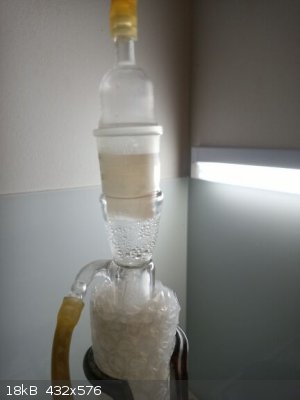
reflux after 40 minutes, much more proline dissolved but there is still visible some proline cooked into white pieces

reflux after 2 hours only a little of proline cooked into one piece visible floating on surface in the left part of the flask

reflux after 8 hours (proline dissolved already after 5 hours)

after cooling down the reaction mixture separated into bottom yellow aqueous viscous phase (P1) and upper dark red organic layer (P2)
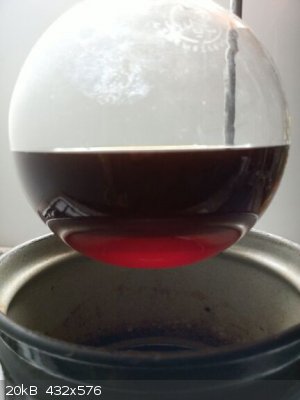 
|
|
|
Fery
International Hazard
    
Posts: 1052
Registered: 27-8-2019
Location: Czechoslovakia
Member Is Offline
|
|
separation of P2 upper phase (organic, dark red, 269,2 g) and P1 bottom phase (aqueous, viscous, yellow, 148,8 g)
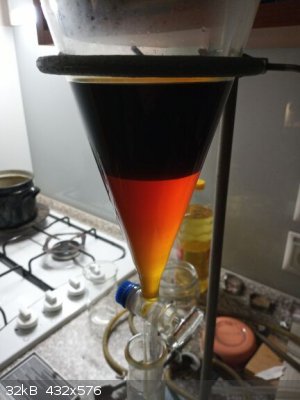
P2 made immediately carbonates on glass due to free amine base present

P1 on left, P2 on right

neutralization of P1 with part of diluted HCl (exothermic, slow addition, swirling in a pot with water/ice/snow) - better to do it outside or in fume
hood
 
after addition of 150 ml of dil. HCl the fumes not anymore, but the still content slightly alkaline on universal indicator paper

P1 after partial adicification separated into bottom aqueous phase P1.1 and a little of upper organic layer P1.2, the upper organic phase P1.2 was
added into P2
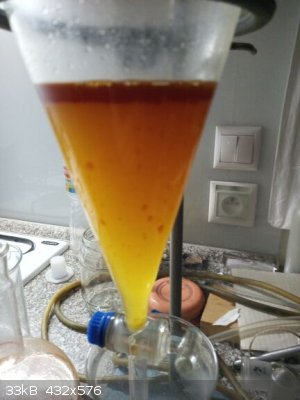
P2 + P1.2 after acidification with 300 ml of dil. HCl (50 ml HCl stayed in beaker which was later added into P1.1 which changed P1.1. pH from slightly
alkaline to neutral), P2 was then stirred for 30 minutes

P1.1 after addition of totally 200 ml of dil. HCl (initially 150 ml of HCl and finally the rest of 50 ml of HCl)

P2+P1.2+HCl separated into aqueous upper layer P2.2 (which was similar to P1.1) and bottom organic phase P2.1 (which was similar to P1.2), here on
picture - left in a beaker P1.1, right up separatory funnel P2.2, right down P2.1 phase already drained into a glass jar for waste acetophenone
(acetophenone could be recovered but I did not try)

P1.1 from beaker transferred into P2.2 in separatory funnel, final pH of this mixture was = 1 using universal indicator paper
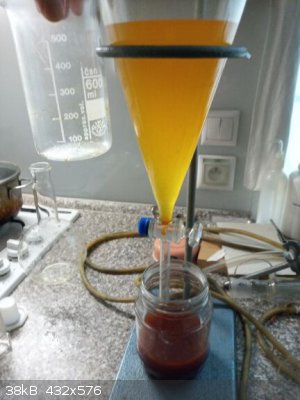
connected aqueous layers with pyrrolidine hydrochloride (and maybe unreacted proline hydrochloride too), (very acidic, pH=1 on universal indicator
paper) with some acetophenone dissolved (solubility of acetophenone in water approximately 5 g per 1 L of pure water at 20 C), it is going to be
distilled to drive out acetophenone with steam (Scr0t used solvent extraction instead)
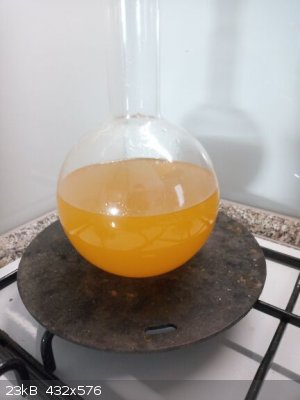
"steam distillation" (eh, in fact it was only a lazy simple distillation without external source of steam)
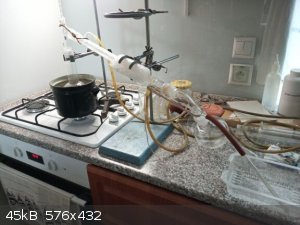
the bubbler was there to trap possible acidic gaseous HCl (possible suck back would not hurt as the distillate was discarded, the important was only
remainder in distillation flask from which acetophenone was removed by steam distillation)
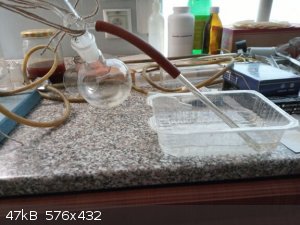
circa 2-5 g acetophenone which sank to bottom (density 1,03 g/ml), I'm not sure whether the steam also did not drive out also pyrrolidine (but the pH
was very acidic so no freebase of amine present in distillation flask and the distillation temperature was 99-102 C)

remainder in the flask after distilling out acetophenone, note the color change from original yellow to dark red (maybe this darkening of color is due
to aldol condensation of acetophenone in acidic HCl environment during boil?)

preparing concentrated solution of 120 g NaOH in H2O, very exothermic, NaOH added in small portions, it was necessary to cool it in cold bath, covered
the opening of beaker with RBF to minimize air and CO2 entering and prevent to spattering corrosive hydroxide from the beaker on magnetic stirring

addition of NaOH into remainder in distillation flask, exothermic, in small portions, swirling the flask in a pot with water/ice/snow bath, white
fumes, I did it outside, this makes free base of pyrrolidine from its hydrochloride salt
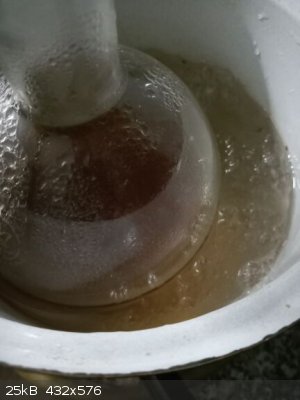
|
|
|
Fery
International Hazard
    
Posts: 1052
Registered: 27-8-2019
Location: Czechoslovakia
Member Is Offline
|
|
distillation
the mixture to distill - a lot of salt on bottom, some dark red on top and the most important is the middle layer which contains aqueous solution of
pyrrolidine

because of the salt present on bottom this could be distilled only with stirring to prevent ugly bumping (local overheating below the insulating layer
of salt)

distillate started to collect at 89 C (pyrrolidine + little of water)

first drops of pyrrolidine, again immediately formation of white carbonates on flask walls
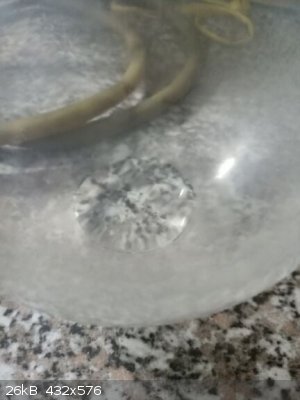
more pyrrolidine + water collected when T in distillation adapter head 95,5 C
 
distillation finished when T raised to 97 C

the mixture of pyrrolidine and water was treated with NaOH, bottom hydroxide layer discarded and upper pyrrolidine layer separated and trasferred into
250 ml RBF, here whole distillation apparatus for final distillation, the hose from take-off adapter lead outside of lab to simulate octopus cooking
inside of building

distillation started at 85 C
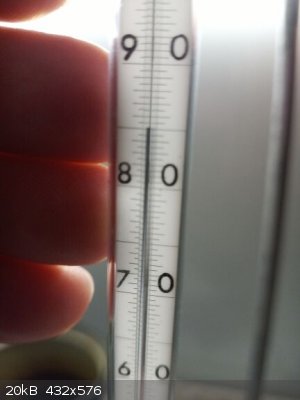
most of distillate passed at 86 C (pyrrolidine lit. b.p.87 C at norm. atm. pressure, here some bad weather with low pressure so the b.p. matches
nicely)
  
distillation finished when T 89 C
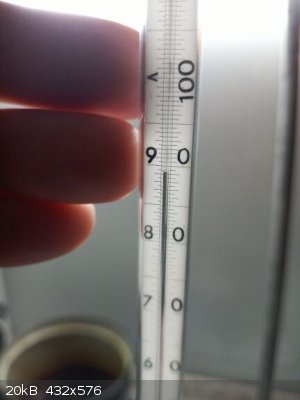 
|
|
|
Fery
International Hazard
    
Posts: 1052
Registered: 27-8-2019
Location: Czechoslovakia
Member Is Offline
|
|
also one hint from theoretical calculations:
weight of reactants (2,05 mol acetophenone + 2,00 mol proline)
246,2 g + 230,3 g = 476,5 g
weight of products (P1 + P2)
148,8 g + 269,2 g = 418 g
weight difference 58,5 g, assume this is CO2 escaping (Molar mass 44 g/mol) = 1,33 mol of CO2
but it is still not clear whether only 1,33 mol of proline from total 2,00 mols decarboxylated or whether most of it did but some CO2 stayed trapped
with pyrrolidine as its carbonate salt (e.g. 100% of proline decarboxylated = 2,00 mol and 0,67 mol of CO2 stayed trapped as pyrrolidine carbonate)...
but according my low yield only 52% (1,04 mol of pyrrolidine) much more probable explanation is that only 1,33 mol of proline decarboxylated, 0,67 mol
of proline didn't which made the P1 very viscous
Anyway if anyone have a lot of cheap or abundant proline and only a little of acetophenone the ratio 1,02 mol acetophenone : 1,00 mol proline is way
to go too. Also recovering acetophenone after the reaction (steam distillation or vacuum distillation - but I wonder how much of acetophenone lost due
to aldol condensation in HCl and in NaOH)
|
|
|
Mateo_swe
National Hazard
   
Posts: 560
Registered: 24-8-2019
Location: Within EU
Member Is Offline
|
|
Added a paper "Organocatalytic decarboxylation of amino acids as a route to biobased amines and amides".
They test 32 different organocatalysts and found that Isophorone was very effective.
Also added a paper "Hydrothermal degradation of amino acids" that seem interesting.
Attachment: Organocatalytic decarboxylation of amino acids as a route to biobased amines and amides.pdf (3.9MB)
This file has been downloaded 385 times
Attachment: Hydrothermal degradation of amino acids.pdf (1.1MB)
This file has been downloaded 339 times
|
|
|
SplendidAcylation
Hazard to Others
  
Posts: 209
Registered: 28-10-2018
Location: Starving in some deep mystery
Member Is Offline
Mood: No one I think is in my tree.
|
|
Scr0t and Fery, thanks, on behalf of everyone, for your efforts!
I noticed something that seemed to have been overlooked on Pumukli's excellent Proline Decarboxylation thread;
He seemed to have success using just 0.1 molar equivalents of acetophenone:
https://www.sciencemadness.org/whisper/viewthread.php?tid=11...
I will be trying this reaction myself soon, probably using 0.1 molar eq. of acetophenone in kerosene as Pumukli did!
|
|
|